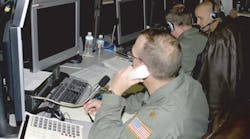By George S. Nitschke
Systems designers are using commercial off the shelf (COTS) electronics on military platforms to leverage technology growth and maximize affordability. The use of COTS on military-platforms is no longer the "way of the future," rather it is the "here and now."
However the environmental interface necessary for typical COTS electronics is far less robust than those interfaces provided by typical military platforms. While in some cases the platform itself will partially bridge the interface disconnects, such as for equipment mounted within a pressurized hull, there will be operational areas where the COTS requirements will conflict with the military platform's environmental envelope.
These environmental interface disconnects can be partially, and in some cases completely, mitigated by a combination of the following:
- procuring electronics with increased ruggedness;
- ruggedizing the less rugged COTS; and
- using platform-specific, unique operating procedures to protect the COTS within the military-grade environments.
With the first option also comes increased costs and a decreased supplier/technology base as most suppliers and advancements are targeted towards the desktop-level environment.
The second option increases costs, such as extra manufacturing, qualification testing, and adding complexity with respect to configuration control and cross-vendor sourcing.
The third option requires in-depth coordination with each proposed platform's operators and maintainers to develop new operating procedures while complicating training and support equipment requirements.
None of these three options, however, ensures the open environmental integration, or "envirogration," of COTS across a variety of military platforms. The use of these options to-date has led to ad hoc, point solutions, which are not conducive to the seamless insertion of COTS technologies.
Open COTS Environmental Interface
One solution is an Open COTS Environmental Interface (OCEI). This refers to a standard military interface in terms of size, mounting, cooling, and power interfaces such as ARINC. Externally, the installation would match the typical military specifications
The OECI approach calls for designers to mount the COTS electronics inside the box along with the requisite enabling mechanical system(s) (EMS). The EMS maintains a COTS-friendly environment within the box. The EMS would be plug-and-play, dependent on the environmental dictates of the particular installation, for example, to provide added temperature control.
The OCEI will enable systems integrators to implement COTS-populated boxes across a wide variety of military platforms while avoiding costly — and potentially defeating — platform-specific envirogration issues. Users can control the OCEI using standards-based criteria such as an OCEI STD, which they can structure as independent of the platform, environment, or customer. This allows for the seamless envirogration of COTS into military platforms.
The OCEI STD interface will be independently qualified, thereby allowing designers to insert the COTS hardware as pre-qualified hardware, facilitating streamlined technology insertion and near-effortless cyclic upgrades.
The OCEI STD, in fact, could lead to a common sustainment scheme, freeing resources for improving military systems versus sustaining them. As the proliferation of COTS increases, the OCEI STD will have an ever-increasing, mutual utility to industry and government. Since commercial aviation standards are typically more stringent than those for office-environment COTS, the OCEI standard will also have use to the commercial fleet manufacturers and operators as they are also working to incorporate COTS technologies.
The OECI approach
A consortium is forming under the aegis of the Government Electronics and Information Technology Association (GEIA) in Arlington, Va., a component of the Electronic Industries Alliance (EIA). Members of the consortium are to develop an OCEI STD and promote its implementation.
The consortium will operate as an independent body seeking a win-win COTS envirogration solution for industry suppliers and government customers, and develop a consensus-based OCEI standard to enable the seamless insertion of COTS technologies into military platforms.
The consortium membership is forming from a group of prime contractors, subcontractors, board manufacturers, and defense customers who are, or will be, envirograting COTS into military platforms.
The GEIA hosted a kick-off meeting at their Arlington, Va., headquarters on 22 June 2000 for 14 companies and government agencies who have expressed an early interest in the OCEI.
For information contact Chris Denham, 703-907-7568, or see http://www.geia.org/eoc/cots.html.
The potential core membership is in the process of drafting the consortium's charter and working plan. A consortium-elected chair and steering committee will lead the effort. The MITRE Corporation is providing technical participation in the consortium's start-up and ongoing activities.
George S. Nitschke is senior mechanical engineer of sensors and enabling technology at the Mitre Corporation in Bedford, Mass. For more information contact him by e-mail at [email protected].


